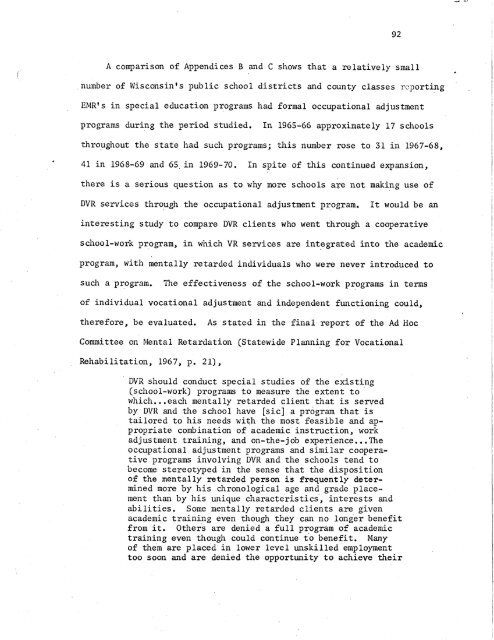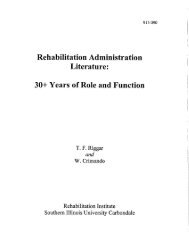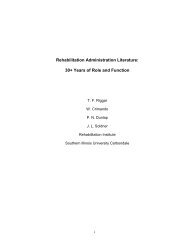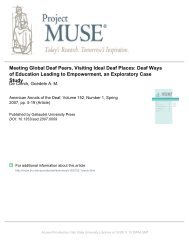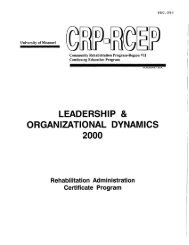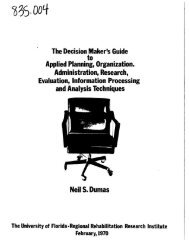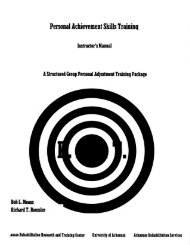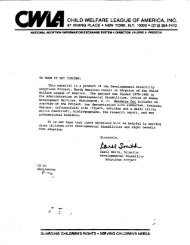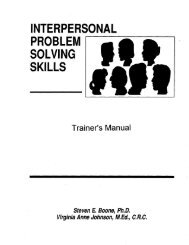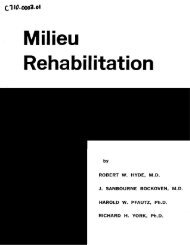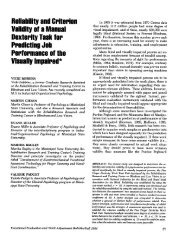by requirements for the degree of (Education) - NCRTM
by requirements for the degree of (Education) - NCRTM
by requirements for the degree of (Education) - NCRTM
Create successful ePaper yourself
Turn your PDF publications into a flip-book with our unique Google optimized e-Paper software.
A comparison <strong>of</strong> Appendices B and C shows that a relatively small<br />
number <strong>of</strong> Wisconsin's public school districts and county classes reporting<br />
EMR's in special education Programs had <strong>for</strong>mal occupational adjustment<br />
programs during <strong>the</strong> period studied. In 1965-66 approximately 17 schools<br />
throughout <strong>the</strong> state had such Programs; this number rose to 31 in 1967-68,<br />
41 in 1968-69 and 6S in 1969-70. In spite <strong>of</strong> this continued expansion,<br />
<strong>the</strong>re is a serious question as to why more schools are not making use <strong>of</strong><br />
DVR services through <strong>the</strong> occupational adjustment Program. It would be an<br />
study to compare DVR clients who went through a cooperative<br />
interesting<br />
program in which VR services are integrated into <strong>the</strong> academic<br />
school-work<br />
program, with mentally retarded individuals who were never introduced to<br />
such a program. The effectiveness <strong>of</strong> <strong>the</strong> school-work Programs in terms<br />
<strong>of</strong> individual vocational adjustment and independent functioning could,<br />
<strong>the</strong>re<strong>for</strong>e, be evaluated. As stated in <strong>the</strong> final report <strong>of</strong> <strong>the</strong> Ad Hoc<br />
Committee on Mental Retardation (Statewide Planning <strong>for</strong> Vocational<br />
Rehabilitation, 1967, p. 21),<br />
should conduct special studies <strong>of</strong> <strong>the</strong> existing<br />
DVR<br />
Programs to measure <strong>the</strong> extent to<br />
(school-work)<br />
mentally retarded client that is served<br />
which...each<br />
DVR and <strong>the</strong> school have [sic] a program that is<br />
<strong>by</strong><br />
to his needs with <strong>the</strong> most feasible and ap-<br />
tailored<br />
combination <strong>of</strong> academic instruction, work<br />
propriate<br />
training, and on-<strong>the</strong>-job experience...The<br />
adjustment<br />
adjustment programs and similar coopera-<br />
occupational<br />
Programs involving DVR and <strong>the</strong> schools tend to<br />
tive<br />
stereotyped in <strong>the</strong> sense that <strong>the</strong> disposition<br />
become<br />
<strong>the</strong> mentally retarded person is frequently deter-<br />
<strong>of</strong><br />
more <strong>by</strong> his chronological .age and grade place-<br />
mined<br />
than <strong>by</strong> his unique characteristics, interests and<br />
ment<br />
Some mentally retarded clients are given<br />
abilities.<br />
training even though <strong>the</strong>y can no longer benefit<br />
academic<br />
it. O<strong>the</strong>rs are denied a full Program <strong>of</strong> academic<br />
from<br />
even though could continue to benefit. Many<br />
training<br />
<strong>the</strong>m are placed in lower level unskilled employment<br />
<strong>of</strong><br />
soon and are denied <strong>the</strong> opportunity to achieve <strong>the</strong>ir<br />
too<br />
92


